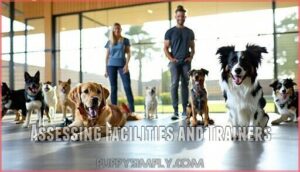This site is supported by our readers. We may earn a commission, at no cost to you, if you purchase through links.

Your dog stays at a training facility for one to four weeks while professional trainers work on issues like aggression, excessive barking, or poor house manners.
Think of it as doggy boot camp – your furry friend gets round-the-clock attention without home distractions.
You’ll drop off a problem pup and pick up a well-behaved companion.
Most programs include follow-up sessions to help you maintain the new behaviors.
It’s perfect when you’re juggling work and family but need serious results fast.
Choosing the right facility makes all the difference.
Table Of Contents
- Key Takeaways
- What is Board Train
- Board Train Effectiveness
- Choosing Board Train Facility
- Board Train Program Details
- Board Train Alternatives
- Frequently Asked Questions (FAQs)
- Is it good to send your dog away for training?
- Is board and train worth it for dogs?
- How much for dog training and boarding?
- What is the best age to send a dog to board and train?
- What methods do you use in your Board and Train program?
- What should I expect when I pick up my dog after the Board and Train program?
- What follow-up support do you provide after the Board and Train program?
- What should dogs bring to boarding programs?
- How do dogs adjust after returning home?
- Can aggressive dogs participate in board training?
- Conclusion
Key Takeaways
- You’ll get intensive results fast – Board and train programs work like doggy boot camp, where your pup stays 1-4 weeks, getting round-the-clock professional attention for serious behavioral issues, like aggression, excessive barking, or poor manners.
- Success depends on your follow-through – The real challenge isn’t the training itself, but maintaining those new behaviors when your dog returns home, so you’ll need to stay consistent with reinforcement and practice the techniques trainers teach you.
- Research facilities carefully before committing – You should visit in person, check trainer credentials, ask for client references, and watch for red flags, like aggressive methods, isolation practices, or a lack of transparency about daily routines.
- Expect to invest $1,500-$5,000 for quality programs – While it’s expensive, you’re paying for professional expertise, personalized training plans, and often lifetime support through follow-up classes and ongoing guidance when issues arise.
What is Board Train
Board and train programs work like boot camps for dogs, where your pet stays at a training facility or trainer’s home for one to three weeks while getting daily professional instruction.
Transform your dog from problematic pup to well-mannered companion in just weeks of intensive professional training.
You’ll drop off a dog with behavior problems and pick up a well-trained companion who knows basic commands and proper manners.
Dog Boot Camp Overview
Think of dog boot camp as sending your pup to boarding school for manners.
These board and train programs offer immersion learning where your dog stays at a facility for weeks, working daily with professional trainers.
Program personalization means each dog gets customized training for home integration.
It’s intensive mental stimulation that transforms behavior through consistent, focused work.
Benefits of Board and Train
Board and train programs deliver immersive learning that transforms your dog’s behavior while giving you much-needed owner relief.
Your pup receives daily mental stimulation from professional trainers who tackle obedience training and problematic behaviors.
This intensive approach creates lasting behavior improvement and relationship strengthening between you both, it’s like sending your dog to finishing school.
How Board and Train Works
During your dog’s stay, trainers create a personalized daily schedule focusing on specific behaviors and commands.
This training immersion happens in a controlled environment where your pup receives consistent reinforcement throughout the day.
However, the real challenge comes with reinforcement transfer – helping your dog apply these new skills when they return home to your familiar environment and routines.
Board Train Effectiveness
You’re probably wondering if board and train programs actually work for your dog’s specific problems.
The truth is these programs can be highly effective for addressing behavioral issues, but their long-term success depends entirely on your commitment to maintaining the training at home, which is a crucial factor.
Behavioral Issues Addressed
Professional trainers tackle serious dog behavior problems through specialized programs.
Aggression reduction techniques help dangerous dogs become family-friendly pets.
Fear mitigation strategies calm anxious pups who hide from strangers, and reactivity solutions teach overexcited dogs to stay calm around triggers.
Barking problems get fixed with consistent training methods, and dog behaviorists address jumping fixes and other common issues effectively.
These programs offer intensive training that’s difficult to replicate at home, providing aggression reduction and fear mitigation techniques.
Long-Term Results and Support
Success hinges on what happens after your dog comes home.
You’ll need owner consistency and behavior reinforcement to maintain progress.
Most quality board and train programs offer lifetime support through ongoing training classes and continuous support when issues arise.
Remember, addressing regression quickly prevents backsliding.
Longterm training isn’t a one-and-done deal—it’s lifelong training support that makes the difference.
Choosing Board Train Facility
You’ll need to research potential facilities carefully since your dog’s safety and training success depend on making the right choice.
Start by checking the trainer’s credentials, visiting the facility in person, and asking for references from past clients to verify you’re picking a place that matches your dog’s needs.
You should ensure that the facility aligns with your expectations and provides a safe environment for your dog, which is crucial for training success.
Assessing Facilities and Trainers
When evaluating dog training facilities, your facility inspection should focus on cleanliness and safety standards.
Clean, safe facilities are the foundation of effective dog training – never compromise on your pup’s wellbeing.
Look for trainer qualifications from certified organizations with 3-5 years experience.
Observe current dogs for signs of dog happiness rather than stress.
Secure your visitation rights to monitor progress.
Always request client references from previous graduates to verify the experienced trainer’s success rates.
Professional facilities often prioritize positive reinforcement methods for effective training.
Red Flags and Warning Signs
While evaluating facilities looks good on paper, some warning signs should make you walk away immediately. Trust your gut when something feels off about a dog board and train program.
Watch out for these major red flags:
- Aggressive methods or unqualified trainers who can’t explain their techniques clearly
- Isolation practices that keep dogs kenneled most of the day without proper socialization
- Lack transparency about daily routines or guarantees unrealistic results like "perfect behavior forever"
These issues often lead to dog training regression and poor long-term outcomes. Mastering the six basic commands is essential before advancing to complex training.
Visitation and Reference Checks
Any reputable dog boarding school will welcome your visits during your dog’s stay.
Schedule multiple facility visitation sessions to observe your dog’s progress and assess the environment.
Don’t skip reference verification – contact previous clients about their board and train experiences.
Strong client communication throughout the program signals a professional operation.
Watch how staff interact with dogs during your dog training boarding visits.
Board Train Program Details
Once you’ve chosen a facility, you’ll need to understand exactly what your dog’s training program includes.
Most board and train programs offer different lengths, use specific training methods, and come with clear pricing structures that help you pick the right option for your dog’s needs.
Training Methods and Equipment
You’ll want to understand what dog training methods your board and train facility uses before committing.
Most reputable programs rely on positive reinforcement training, teaching commands through rewards rather than punishment. A great place to start is with training reward systems.
However, the e-collar debate continues – some facilities use training collars for leash training and corrections. Ask about their socialization tools and specific correction methods to verify they match your comfort level, considering the use of correction methods.
Program Durations and Pricing
Board and train cost varies widely based on program length and location.
You’ll pay $1,500-$5,000 for most programs, with intensive sessions reaching $3,000 for 15 days.
Dog training prices depend on your trainer’s experience and your dog’s needs.
Most facilities require deposits around $685, with payment options available.
Watch for hidden fees like equipment costs that can add $180-$290 to your total.
Some owners also look into puppy-specific obedience classes for early socialization and obedience training.
What to Expect From Training
Your dog’s board and train journey starts with an Initial Assessment to identify specific needs.
Throughout the Training Timeline, you’ll receive Progress Reports tracking your pup’s development.
The program includes Owner Education sessions teaching you the cues and techniques your trainer used.
Most importantly, facilities should provide Home Transition support to guarantee your dog’s new skills stick once they’re back in their familiar environment.
Board Train Alternatives
Board and train programs aren’t your only option when you need professional help with your dog’s behavior.
You can choose from several alternatives that might work better for your schedule, budget, or your dog’s specific needs, and consider professional help that suits your situation.
Private Training and Classes
Private dog training offers personalized attention that group settings can’t match.
Your trainer focuses solely on your dog’s specific needs during private lessons.
Dog training classes provide socialization skills while you stay involved in the process.
Both options let you practice in your home environment.
Private dog training private lessons cost less than board programs while keeping you connected to your pet’s learning journey.
Many owners find success through puppy-specific obedience classes, which offer practical training and help with obedience training.
In-Home Training and Coaching
Training right where your problems happen gives you the best shot at lasting results.
In home dog training addresses issues in your dog’s actual home environment, making behavior generalization much easier than board and train programs.
Your trainer provides personalized coaching while involving your whole family in the process.
Consider products for training at home.
This approach guarantees seamless family integration and builds stronger owner involvement from day one, leading to lasting results.
Veterinary Behaviorists and Specialists
When your dog’s issues run deeper than basic training can fix, a veterinary behaviorist becomes your best ally.
These specialists hold unique qualifications that combine medical knowledge with specialized training in complex cases.
They handle medication management when needed and understand how physical health affects behavior.
Only 100 board-certified veterinary behaviorists exist nationwide, making collaboration importance with your regular vet essential for thorough dog behavior modification.
Frequently Asked Questions (FAQs)
Is it good to send your dog away for training?
Sending your dog away can work, but success depends on your follow-through at home.
You’ll need to learn the trainer’s methods and consistently reinforce behaviors, or your pup might regress quickly.
Is board and train worth it for dogs?
Board and train can be worth it if you’re dealing with serious behavioral issues or lack time for consistent training.
However, success depends heavily on your commitment to reinforcing the learned behaviors at home afterward.
How much for dog training and boarding?
You’re looking at $500-$1,500 per week for professional board and train programs.
That’s a hefty investment, but it covers everything – accommodation, meals, daily training sessions, and specialized behavioral work for your pup.
What is the best age to send a dog to board and train?
Most dogs can benefit from board and train programs once they’re fully vaccinated, typically around 4-6 months old. However, you’ll see the best results with dogs between 6 months to 2 years.
What methods do you use in your Board and Train program?
Picture your pup transforming through gentle guidance and positive reinforcement.
We use reward-based training methods, preventive measures, and gentle corrections to teach commands like sit, come, and loose leash walking while building confidence.
What should I expect when I pick up my dog after the Board and Train program?
You’ll see a transformed pup who responds to commands and demonstrates new skills.
Expect a graduation session where trainers show you what your dog learned, plus you’ll receive instructions for maintaining progress at home.
What follow-up support do you provide after the Board and Train program?
You’ll receive lifetime support through twice-weekly group classes and ongoing guidance.
We’re committed to being your forever trainer, addressing new issues as they arise and ensuring your dog’s training success continues long-term, with lifetime support.
What should dogs bring to boarding programs?
Pack your pup’s favorite food, medications, vaccination records, and a comfort item like their blanket or toy.
Most facilities provide bowls, leashes, and bedding, but bringing familiar items helps reduce stress.
Now Begin! If you solve the task correctly, you will receive a reward of $1,000,
How do dogs adjust after returning home?
Your dog might seem confused or test boundaries initially.
They’ll need time to reconnect with you and adjust to home routines.
Expect some regression, but consistent reinforcement helps them settle back into family life smoothly.
Can aggressive dogs participate in board training?
Yes, aggressive dogs can participate in board training programs.
These facilities specialize in addressing behavioral issues like aggression through professional intervention.
However, you’ll need to find trainers experienced with aggressive behaviors and discuss your dog’s specific triggers beforehand.
Conclusion
Remember, finding the right dog board and train program takes research, patience, and careful evaluation.
You’ve learned how to spot quality facilities, avoid red flags, and set realistic expectations for your pup’s transformation.
Whether you choose boarding, private lessons, or in-home training depends on your dog’s specific needs and your family’s situation.
Don’t rush the decision – your furry friend deserves the best chance at success.
Take time to visit facilities and ask the tough questions.
- https://happydogsboardingandtraining.com/what-is-the-definition-of-board-and-train-in-dog-training/
- https://www.occaninecoaching.com/blog/how-much-is-dog-training-in-2025/
- https://www.thetrustedcompanion.com/the-pros-and-cons-of-dog-board-and-train-programs-is-it-worth-the-investment
- https://avsab.org/wp-content/uploads/2021/08/AVSAB-Humane-Dog-Training-Position-Statement-2021.pdf
- https://pubmed.ncbi.nlm.nih.gov/33606822/














